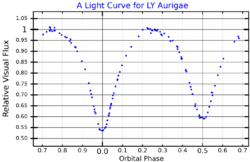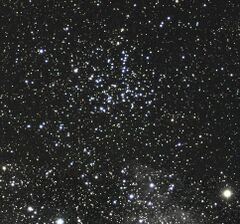Astronomy:LY Aurigae
| Observation data Equinox J2000.0]] (ICRS) | |
|---|---|
| Constellation | Auriga |
| Right ascension | 05h 29m 42.650s[1] |
| Declination | +35° 22′ 30.09″[1] |
| Apparent magnitude (V) | 6.85[2] (6.66 - 7.35[3]) |
| Characteristics | |
| Spectral type | O9II + O9III + B0.5III[4] |
| U−B color index | −0.78[5] |
| B−V color index | +0.20[5] |
| Variable type | β Lyr[2] |
| Astrometry | |
| Proper motion (μ) | RA: −0.20±3.19[1] mas/yr Dec.: −1.17±2.07[1] mas/yr |
| Parallax (π) | 3.28 ± 2.40[1] mas |
| Distance | approx. 1,000 ly (approx. 300 pc) |
| Absolute magnitude (MV) | −5.62 + −5.11 + −4.43[4] |
| Orbit[4] | |
| Primary | Aa |
| Companion | Ab |
| Period (P) | 4.0025 days |
| Semi-major axis (a) | 36.1 R☉ |
| Eccentricity (e) | 0.0 |
| Inclination (i) | 87.7° |
| Semi-amplitude (K1) (primary) | 161.9 km/s |
| Semi-amplitude (K2) (secondary) | 294.3 km/s |
| Orbit[4] | |
| Primary | Ba |
| Companion | Bb |
| Period (P) | 20.4642 days |
| Eccentricity (e) | 0.246 |
| Semi-amplitude (K1) (primary) | 33.0 km/s |
| Details[4] | |
| Aa | |
| Mass | 25.5 M☉ |
| Radius | 16.1 R☉ |
| Luminosity | 214,000 L☉ |
| Surface gravity (log g) | 3.425 cgs |
| Temperature | 31,000 K |
| Rotational velocity (v sin i) | 194 km/s |
| Ab | |
| Mass | 14.0 M☉ |
| Radius | 12.6 R☉ |
| Luminosity | 135,000 L☉ |
| Surface gravity (log g) | 3.378 cgs |
| Temperature | 31,150 K |
| Rotational velocity (v sin i) | 152 km/s |
| B | |
| Luminosity | 47,000 L☉ |
| Surface gravity (log g) | 4.00 cgs |
| Temperature | 26,000 K |
| Rotational velocity (v sin i) | 30 km/s |
| Age | 5 Myr |
| Other designations | |
| Database references | |
| SIMBAD | data |
LY Aurigae is a multiple star system in the constellation Auriga. It is an eclipsing binary variable star, dropping in brightness by 0.7 magnitudes every 4 days. The system is around a thousand light years away in the Auriga OB1 stellar association.
System
LY Aurigae is a close visual binary. The two stars are magnitude 6.85[6] and magnitude 8.35[7] 0.6 arc-seconds apart. Each star is also a spectroscopic binary.

LY Aur A is a double-lined spectroscopic binary with an O9 bright giant and an O9 giant star in contact and eclipsing each other as they orbit every 4 days. It is classified as a Beta Lyr eclipsing variable system. The primary eclipse is 0.69 magnitudes deep and the secondary eclipse is 0.60 magnitudes.[9] Because of the contact nature of the system and the deformed shapes of the stars, the magnitude varies constantly throughout the orbital cycle. The orbital period is slowly changing due to mass exchange between the stars. Each star is over a hundred thousand times the luminosity of the sun.[4]
LY Aur B is a single-lined spectroscopic binary with an orbital period of 20.5 days. It is probably an early B main sequence star and the companion is undetectable. The two stars combined are 47,000 times the luminosity of the sun.[4]
References
- ↑ 1.0 1.1 1.2 1.3 1.4 van Leeuwen, F. (2007). "Validation of the new Hipparcos reduction". Astronomy and Astrophysics 474 (2): 653–664. doi:10.1051/0004-6361:20078357. Bibcode: 2007A&A...474..653V. http://www.aanda.org/index.php?option=com_article&access=bibcode&Itemid=129&bibcode=2007A%2526A...474..653VFUL. Vizier catalog entry
- ↑ 2.0 2.1 Stickland, D. J. (1994). "Spectroscopic binary orbits from ultraviolet radial velocities. Paper 15: LY Aurigae (HD 35921)". The Observatory 114: 107–113. Bibcode: 1994Obs...114..107S.
- ↑ Samus, N. N. et al. (2009). "VizieR Online Data Catalog: General Catalogue of Variable Stars (Samus+ 2007-2013)". VizieR On-line Data Catalog: B/GCVS. Originally Published in: 2009yCat....102025S 1. Bibcode: 2009yCat....102025S.
- ↑ 4.0 4.1 4.2 4.3 4.4 4.5 4.6 Mayer, Pavel; Drechsel, Horst; Harmanec, Petr; Yang, Stephenson; Šlechta, Miroslav (2013). "The O-type eclipsing contact binary LY Aurigae - member of a quadruple system". Astronomy & Astrophysics 559: A22. doi:10.1051/0004-6361/201322153. Bibcode: 2013A&A...559A..22M.
- ↑ 5.0 5.1 Mayer, P.; Papoušek, J. (1988). "New photometric data on LY Aurigae". Contributions of the Astronomical Institute of Brno 26. Bibcode: 1988CoBrn..26.....M.
- ↑ Paunzen, E. (2015). "A new catalogue of Strömgren-Crawford uvbyβ photometry". Astronomy & Astrophysics 580: A23. doi:10.1051/0004-6361/201526413. Bibcode: 2015A&A...580A..23P.
- ↑ Fabricius, C.; Høg, E.; Makarov, V. V.; Mason, B. D.; Wycoff, G. L.; Urban, S. E. (2002). "The Tycho double star catalogue". Astronomy and Astrophysics 384: 180–189. doi:10.1051/0004-6361:20011822. Bibcode: 2002A&A...384..180F.
- ↑ Mayer, Pavel; Drechsel, Horst; Harmanec, Petr; Yang, Stephenson; Šlechta, Miroslav (November 2013). "The O-type eclipsing contact binary LY Aurigae – member of a quadruple system". Astronomy & Astrophysics 559: A22. doi:10.1051/0004-6361/201322153. Bibcode: 2013A&A...559A..22M.
- ↑ Malkov, O. Yu.; Oblak, E.; Snegireva, E. A.; Torra, J. (2006). "A catalogue of eclipsing variables". Astronomy and Astrophysics 446 (2): 785. doi:10.1051/0004-6361:20053137. Bibcode: 2006A&A...446..785M.
See also
 |


